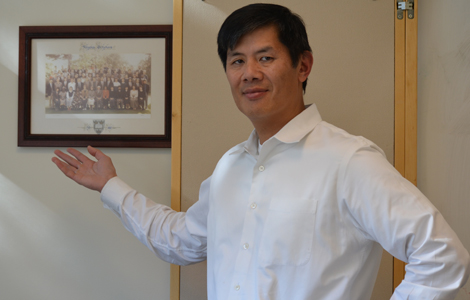Chinese, US, Brazilian mothers-to-be take part in study
Updated: 2014-07-16 03:50
By Chris Davis(China Daily USA)
|
||||||||
For generations it has been an accepted fact that babies born in some parts of the world are smaller those born in other places. The wide disparities in the average size of infants at birth have been written off as a matter of race or ethnicity. Until now.
An expansive five-year-long study involving 60,000 expectant mothers from eight international population centers — including China, Brazil and the United State — and bank-rolled by a Bill and Melinda Gates Foundation grant to Oxford University has found that babies' growth in the womb and length at birth are strikingly similar the world over.

The caveat being — as long as those babies are born to mothers who are healthy, well-educated and well-nourished.
"Currently we are not all equal at birth, but we can be," said lead author professor Jose Villar of the Nuffield Department of Obstetrics and Gynaecology at Oxford. "We can create a similar start for all by making sure mothers are well educated and nourished, by treating infection and by providing adequate antenatal care."
One of the study's lead investigators, professor Ruyan Pang of Peking University, said, "Having international standards of optimal growth from conception to five years of age that everyone in the world can use means it will now be possible to evaluate improvements in health and nutrition using the same yardstick."
Small, undernourished babies face a number of short- and long-term health issues. In 2010, an estimated 27 percent (or 32.4 million) of babies born worldwide were undernourished. Mostly in poor and middle-income countries, those births were most closely associated with illness and death in infancy and childhood and higher risks of diabetes, high blood pressure and cardiovascular disease as adults.
The study followed 60,000 pregnancies in eight defined urban areas: Pelotas, Brazil; Turin, Italy; Muscat, Oman; Oxford, England; Seattle, Washington; Shunyi County, Beijing, Nagpur, India; and the Parklands neighborhood of Nairobi, Kenya.
The women recruited had to be between 18 and 35 years old, have no relevant obstetric or gynecological history and meet certain criteria of optimal health, nutrition, education and socioeconomic status. They had to live in places that had no known contamination, pollution, domestic smoke, radiation or other toxic substances. Women in low- and middle-income countries were given iron and folic acid supplements.
The women had ultrasound scans every five weeks using the standard fetal measurements of head side-to-side diameter and circumference, abdominal circumference and femur length, as well as newborn size.
Studying "60,000 pregnant women at eight very different sites, including standardization of the clinical practice of more than 300 health professionals and monitoring of the quality of their data," the authors write, "was a major challenge".
But the data bear out that "fetal skeletal growth and newborn linear size are strikingly similar among geographically diverse populations when mothers' environmental, health and nutritional conditions are met", the study concludes.
The next step is to use these findings to establish international standards for evaluating fetal growth and newborn size, which are currently measured in clinics around the world using more than 100 different charts.
"This is very confusing for doctors and mothers and makes no biological sense," said Oxford professor Stephen Kennedy, one of the study's senior authors. "How can a fetus or a newborn be judged small in one clinic or hospital and treated accordingly, only for the mother to go to another city or country, and be told that her baby is growing normally?"
As Villar put it: "If your cholesterol or your blood pressure are high, they are high regardless of where you live. Why should the same not apply to growth?"
The fact that when mothers are in good health, babies grow in the womb in very similar ways the world over is "a tremendously positive message of hope for all women and their families," said professor Zulfiqar Bhutta of the Aga Khan University in Karachi, Pakistan, who chaired the study's steering committee.
"But there is a challenge as well," Zulfiqar added. "This is about the health and life chances of future citizens everywhere on the planet. All those who are responsible for health care will have to think about providing the best possible maternal and child health."
Lead author Villar put it best: "Don't tell us nothing can be done. Don't say that women in some parts of the world have small children because they are predestined to do so. It's simply not true."

 Music at her fingers
Music at her fingers
 Across America Over the Week (Jan 16 - Jan 22)
Across America Over the Week (Jan 16 - Jan 22)
 Spend Chinese New Year in style
Spend Chinese New Year in style
 Ili river valley becomes a popular destination for swans
Ili river valley becomes a popular destination for swans
 Philip Ma: from scientist to businessman
Philip Ma: from scientist to businessman
 Birmingham's Spotlight on China dinner
Birmingham's Spotlight on China dinner
 How to distinguish doucai, wucai, Famille-rose and enamel porcelain
How to distinguish doucai, wucai, Famille-rose and enamel porcelain
 Xinjiang lake in bumper fishing season
Xinjiang lake in bumper fishing season
Most Viewed
Editor's Picks

|

|

|

|

|

|
Today's Top News
Houston's SW Chinatown
China to focus on reforms, opening of capital market
Slowdown brings new risks to banks
Trade group calls for BIT
Market status for China is 'political' issue
Birmingham's Spotlight on China dinner
Bank takes renminbi-clearing seriously
Traditional Garb
US Weekly

|

|








